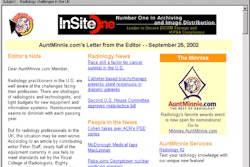NEW ORLEANS - Equipment downtime is anathema to an imaging center administrator. A broken modality means patient rescheduling, professional staff standing idle, and the understandable ire of radiologists and referring physicians who have to wait longer than expected for reports. With these realities in mind, many administrators are willing to pay a premium for service contracts from modality manufacturers.
"The most costly method of covering equipment repair costs is through an original equipment manufacturer (OEM) service contract," said James Guirsch, vice president of vendor relations with Brookfield, WI-based USCS Equipment Technology Solutions.
In a presentation at the American Healthcare Radiology Administrators meeting, Guirsch noted that most healthcare facilities use a combination of in-house service, maintenance contracts, and service purchased on a time-and-materials basis for their high-end clinical equipment. The main drawback to maintenance contracts is that healthcare organizations relinquish internal control by giving the vendors complete control of the repair process.
"Without control, there is no management," he said.
There are, however steps an administrator can implement to assist in keeping future contract costs low. These include:
- Checking in and checking out all vendor service engineers as they enter and exit the facility. This record will provide a metric of actual on-site time per repair.
- Monitor and inventory all parts that are replaced to ensure that only defective parts are replaced.
- Research alternative pricing for expensive parts so that the facility can protect itself against unwarranted service contract price increases.
- Establish a group of in-house service personnel that can continually monitor the progress of the vendor’s service engineer.
- Only permit the vendor’s representative to touch the equipment when the facility deems it to be necessary.
Managers should also take steps to ensure that the clinical equipment is located in the best possible environment in order to reduce downtime. They should ensure that the power for the modality is clean and uninterruptible, and that appliances such as coffee makers and copiers aren't sharing the same power line.
Providing a temperature and humidity-controlled area for the modality will ensure that electronic components in the equipment operate in an optimum environment. In addition, an administrator should control the number of inexperienced operators who utilize a piece of equipment at a time, and should distribute the workload over multiple units, if they are available.
A facility should consider having its in-house personnel learn the necessary skills to conduct preventive maintenance on its electromechanical and mechanical clinical equipment. By bringing preventive maintenance in-house, a facility can save money on its service contracts, and schedule the tasks to be performed on off-hours when the modality is not being used.
Caveat emptor
"Due to an ongoing decline in the sale of new equipment, many vendors have turned to their service division as a way to protect their income stream," Guirsch said.
Vendor service managers are thus under the same pressure to boost revenue as are radiology administrators. As such, there are common techniques that vendors use to increase their time-and-materials charges. Guirsch recommended that time-and-materials maintenance be part of any purchase contract -- and that it be negotiated before bringing the vendor’s equipment into the facility.
"Managing is better than fixing," he said.
However, many imaging centers have not added time-and-materials maintenance to their purchase contracts; but they are not entirely at the mercy of revenue-hungry service managers. Guirsch advocated the following techniques to deal with some of the more common ways to inflate time-and-materials bills.
Travel time. An imaging center should only pay for the travel time of a service engineer from the nearest service facility. Some vendors will try to bill clients for travel of a service engineer from several states away, because the local engineer is handling another client.
"The vendor’s staffing problem is not your financial responsibility," Guirsch said.
Flat minimum labor charges. If a facility’s service contract calls for a flat labor charge of four hours per incident, the administrator should insist the service engineer stay on site for the entire four hours, even if the repair only took an hour. Most service managers will be willing to renegotiate the service contract to actual time on site once this tactic is employed.
"If the service manager doesn’t want to renegotiate, at least you’ll be getting full value for your dollar. In some cases, this means getting the most expensive janitorial service imaginable. However, at a billable rate of many hundreds of dollars per hour, most service managers will want their service engineers out with another client bringing in revenue, not dusting equipment cases at your facility," noted Guirsch.
Parts. Check with the vendor on each part replaced to find out if there is a return credit for the part. If there is, insist that the credit be on the invoice for the replacement part before the invoice is paid. A vendor will often drag its feet issuing a credit, but if the credit is contingent on the company being paid for services rendered, it will be a little quicker in reimbursing the facility for the part return, according to Guirsch.
"As a condition of purchase, it is proper to expect quality service on a timely basis and at a reasonable cost," he said. "When this doesn’t happen, a knowledgeable internal maintenance resource can play an important part in implementing effective strategies to control the maintenance process, thereby reducing costs. Key to their success is the level of cooperation they provide to and receive from other departments in their organization."
By Jonathan S. Batchelor
AuntMinnie.com staff writer
July 30, 2002
Copyright © 2002 AuntMinnie.com



















